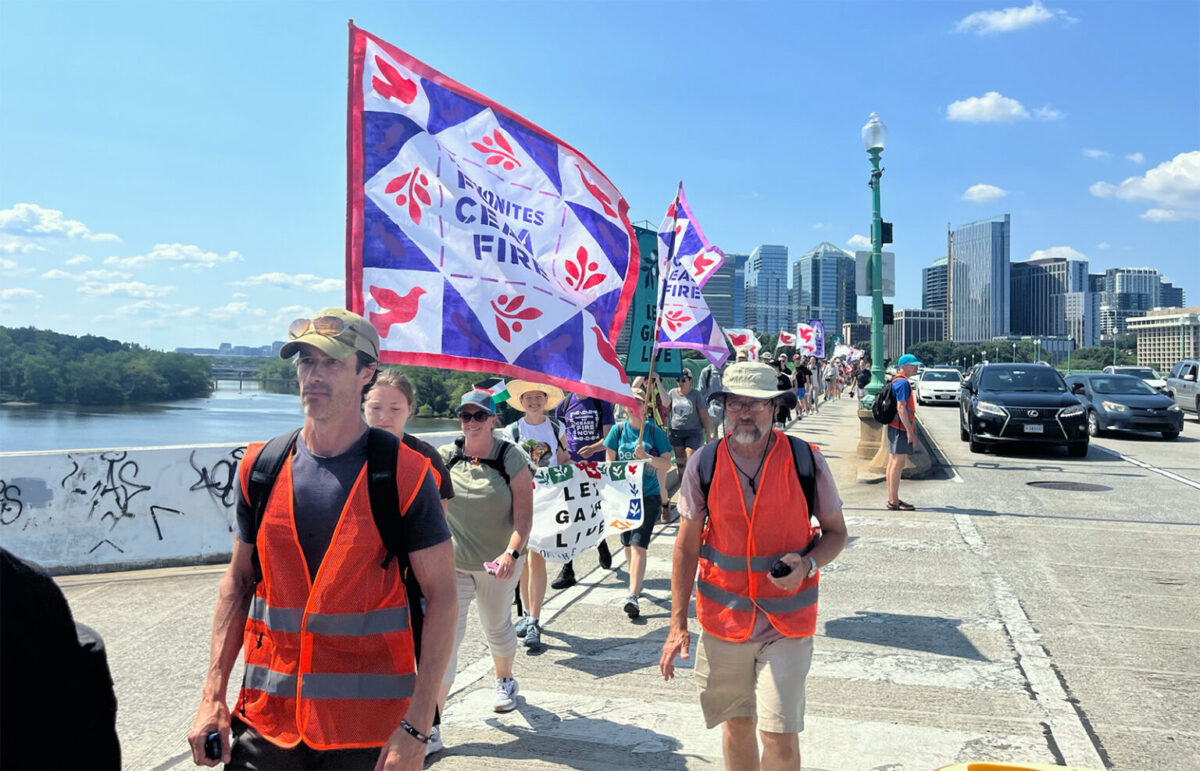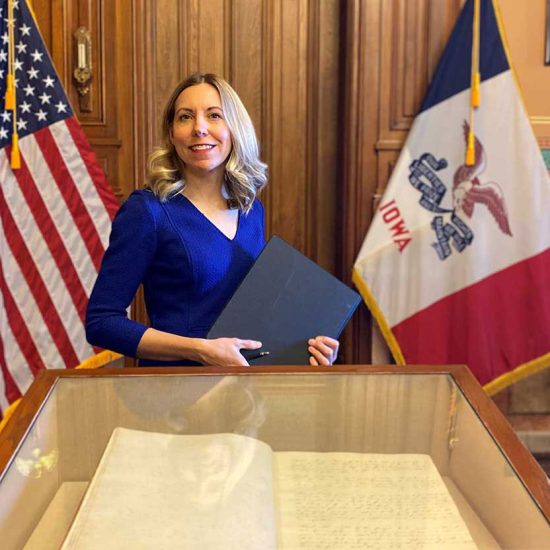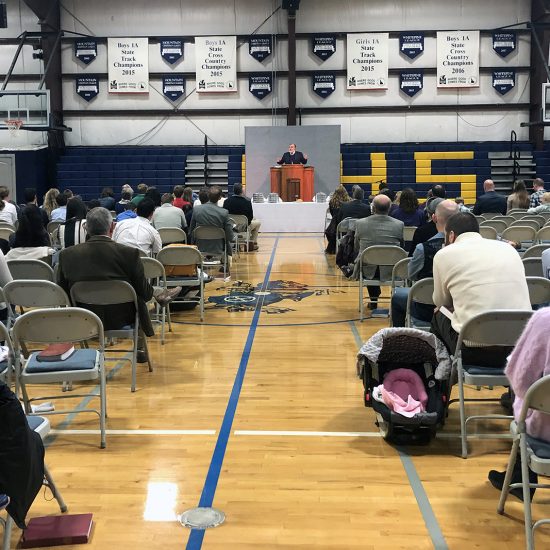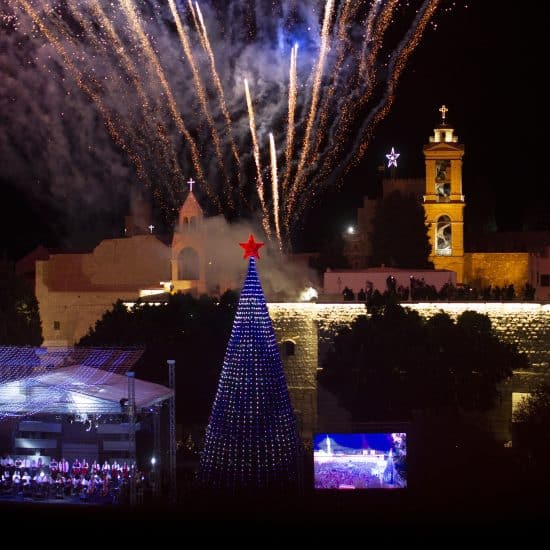
WASHINGTON (RNS) — Many of the Mennonites who marched over 135 miles from Harrisonburg, Virginia, to the White House had someone in mind as they walked, nursing blisters and removing ticks as they crossed the Blue Ridge Mountains and the Shenandoah Valley in 11 days.
For Aidan Yoder, an organizer and college student at Eastern Mennonite University in Harrisonburg, it was the people he met while visiting the West Bank in Palestine during the summer of 2023 on an intercultural college program. One of them was a dancer from Gaza who could not visit her family due to Israeli restrictions on movement, and another was an Arabic teacher who told him she is afraid that her community will face the same devastating bombings that have decimated Gaza.

Participants in the “All God’s Children March for a Ceasefire” event cross the Potomac River, Sunday, July 28, 2024, entering Washington, D.C., from Virginia. (RNS photo/Aleja Hertzler-McCain)
Outside the White House on Sunday (July 28), the core group of about 15 who had walked with Yoder every day from the main Mennonite hub in the Southeast U.S. had grown 10 times larger, all gathered in prayer for a cease-fire. The Mennonite tradition developed as a peace church believing that the Gospel teaches nonviolence. Organizers said the group included Mennonites from at least 40 different churches in the U.S. and Canada, as well as interfaith supporters from Catholic, Lutheran, Jewish, evangelical Christian, and Southern Baptist traditions.
“We need to do something that doesn’t make sense because what’s happening in Gaza doesn’t make sense,” said organizer Nick Martin, explaining the rationale behind “All God’s Children March for a Ceasefire.” Martin continued, “It violates all common sense. It violates basic tenets of human compassion.”
Martin said the group had marched through parking lots, along highways, and through suburban neighborhoods. “We felt like we needed to go into places where we would see everyday people and disrupt these spaces where politics supposedly doesn’t exist, but everywhere is political,” he said.
The group had timed their arrival to coincide with the first day of the Christians United for Israel summit, where thousands of pro-Israel activists are expected to gather in National Harbor, Maryland. An interfaith coalition including Christians, Jews, Hindus, and Muslims has planned counter-protests for the duration of the event, which Mennonites plan to join.
In February, an interfaith group led by Faith for Black Lives organized a similar march called “Pilgrimage for Peace” from Independence Hall in Philadelphia to the White House over eight days, starting February 14, a day that commemorates abolitionist Frederick Douglass.

“All God’s Children March for a Ceasefire” participants pose together in front of the White House, Sunday, July 28, 2024, in Washington. (RNS photo/Aleja Hertzler-McCain)
This July march followed months of other actions and organizing by Mennonite Action, a group formed in November to protest for a cease-fire in the Israel-Hamas war and an end to the Israeli occupation of Palestine.
In January, about 130 Mennonites were arrested after holding a cease-fire hymn sing in the Cannon House Office Building. Song leaders kept the group in time and four-part harmony, even after their arms were zip-tied behind their backs, by stomping their feet. In December and March, local groups across the U.S. and Canada visited their representatives’ offices with quilts and more hymns.
On Eastern Mennonite University’s campus in March, students rang the campus bell for each of the people who had been killed in Palestine and Israel since the beginning of the war. At the time, it took three days of ringing the bell from 8:00 a.m. to 8:00 p.m. each day.
Now, more than 39,000 Palestinians have been killed in Gaza since the beginning of Israel’s military campaign, in addition to the 1,200 people killed in Israel during Hamas’ Oct. 7 attacks, according to their respective governments. The students would have to add another day of ringing if they repeated the protest.
In prayer, Sunday’s protesters uplifted current dire conditions in Gaza, where polio is beginning to spread. We repent of “dehumanizing the dead in Gaza, by counting them as numbers, but not as people who have dreams and aspirations,” said one protester. “How long, oh Lord, will this nightmare continue?”
They prayed for Gazans, including Muhammed Bhar, a Palestinian man with Down syndrome and autism, who was found dead by his family one week after an Israeli army dog attacked him. The Israeli military confirmed that soldiers had left Bhar alone after they ordered his family to leave.
For many Mennonites, the Palestinians they thought about as they walked were people they had known from peace and development work.
Mary Yoder, from Columbus, Ohio, thought of a Palestinian shepherd she had been assigned to protect during a mission with Christian Peacemaker Teams, a faith-based nonviolence organization, in the West Bank in the early 2000s. She witnessed an Israeli settler break the shepherd’s ribs in front of her and said that since then, he’s had his ribs broken “all the time,” his arms broken and bruises all over his body.
“So many of the people that I know are being attacked, and so it just leaves me feeling kind of helpless,” Yoder said. But walking with Mennonite Action since Friday has been “invigorating” and “inspiring,” the 63-year-old said. (Aidan and Mary said they were not related. Yoder is a common Mennonite last name.)

Anna Johnson carries a sign while marching through Washington, D.C., Sunday, July 28, 2024. (RNS photo/Aleja Hertzler-McCain)
Anna Johnson, who walked on Sunday with her mother, a Lutheran pastor, told RNS she became Mennonite after learning about Mennonite Central Committee’s work while she was serving with Lutherans in Palestine. Out of her seven years living in Palestine, she served with the Mennonite development and peace organization for three, coordinating learning tours in Bethlehem.
“I communicate regularly with friends in Gaza, and they’re so tired and scared for their children,” said Johnson, now a member of Kern Road Mennonite Church, in South Bend, Indiana.
Johnson said that being in community gave her strength to continue, even as she doesn’t have a lot of hope. “Fundamentally, I continue through fatigue because my friends in Palestine don’t have the choice to stop until they are free. Neither do I,” she said.
Mennonite Central Committee has worked in the West Bank since 1949, just a year after the Nakba, the Palestinian word for the Zionist violence and intimidation that drove about 750,000 Palestinians from their homes. The Nakba began a day after Israel declared independence, after British forces withdrew from the region and neighboring Arab states attacked Israel.
In recent years, Mennonite Central Committee has faced a reckoning for its entanglement with Nazi Germany. The organization was in debt to the German government as Nazis came to power. After World War II, the organization resettled some Nazis, including some complicit in the Holocaust, among 12,000 Mennonite refugees. In 2021, Mennonite Central Committee released internal research about this history and committed to develop antisemitism training for its employees.
“Because of complicity with the genocide of the Holocaust is even more reason for me to be in the streets today saying definitively that we will not be complicit in this genocide,” said Johnson.
Johnson expressed excitement about the opportunity to work together with Jews and Muslims through the interfaith actions of the coming week and spoke about the importance of combating antisemitism “in our theology, in our churches, in our organizing spaces.”

Anti-war protesters march through Washington, D.C., Sunday, July 28, 2024. (RNS photo/Aleja Hertzler-McCain)
Mackenzie Miller, a student at Goshen College, told RNS she sees participating in Mennonite Action protests as another important departure from history, a history of “passive pacifism.”
Historically, Mennonites resisted war by being conscientious objectors and participating in alternative service. But until the 1970s, many Mennonites didn’t vote and avoided involvement in public life, seeking separation as part of the theological imperative to be “in the world but not of it.”
While some Mennonites participated in anti-war protests against the Vietnam War and subsequent wars, Mennonite Action is ramping up an invigorated kind of coordinated activist pacifism that is drawing a broad base of support among the members of Mennonite Church USA, the largest Mennonite denomination in the U.S., which leans to the left on issues of LGBTQ+ inclusion and political involvement compared to more conservative Mennonite groups.
They draw on deep political knowledge with organizer Adam Ramer, who resigned as California Rep. Ro Khanna’s political director after the congressman initially failed to back a cease-fire.

Aidan Yoder, an organizer of “All God’s Children March for a Ceasefire,” at the White House, Sunday, July 28, 2024, in Washington. (RNS photo/Aleja Hertzler-McCain)
“I believe that we need an active pacifism, actively seeking peace, seeking that justice as we care for our neighbors all over the world,” Miller said.
The next generation of Mennonites are embracing that call.
Samuel Miller Gonzalez, a 13-year-old member of Shalom Mennonite Congregation in Harrisonburg, Virginia, told RNS he’d joined the march for four days and camped at farms “to show people in Gaza that we actually care.” His faith taught him that “every single one of us is important. Everybody is the same, so how can you kill somebody that’s just like you?” he said.
Erica Weaver told RNS that her congregation, North Baltimore Mennonite Church, had been praying for a cease-fire. The 14-year-old joined Sunday’s protest because “people’s lives are being taken that don’t deserve it,” she said. “Even kids are getting killed for no reason … kids my age, and they haven’t lived that long.”
For Aidan Yoder, these young families of parents and children fighting for the children of Gaza bring him hope, he told RNS.
Dennis Lehmann told the Mennonites outside the White House he had marched for the children of Gaza. “I walked for the children of Gaza who can no longer walk,” he said, speaking of the children who died by bombs or lack of medicine.
“I also walk for the children of Gaza who still live,” Lehmann continued. “May my walking soften the hearts of our president and our congresspeople. May their hearts become so full of compassion that they demand Israel stop the killing,” he prayed.
Doug Luginbill, the conference minister for Mennonite Church USA’s central district, emphasized to those assembled that their walking “with sore feet and knees and hips and thirsting mouths and hungry bellies” was a choice.
“There are so many who did not choose to leave their homes,” the minister continued. “Some are forced by bombs that we paid for. God forgive us.”
After writing prayers on papers to leave outside the White House, the Mennonites again began singing: “There is more love somewhere/ I’m gonna keep on till I find it.”






